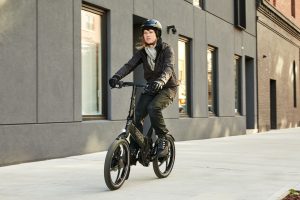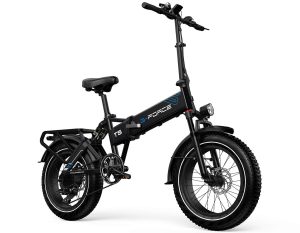Certainly, folding electric bikes are readily available for purchase online and in specialty bike stores.
Benefits of Folding Electric Bikes
Folding electric bikes offer a unique combination of flexibility and efficiency, making them a smart choice for a variety of commuters and cycling enthusiasts. Below we delve into the key benefits that these innovative bikes provide.
Convenience and Portability
One of the most significant advantages of folding electric bikes is their unmatched convenience. Users can quickly fold these bikes down to a compact size, often in less than a minute. This allows for easy transport in the trunk of a car, on public transportation, or even when walking into buildings, making the transition between different modes of travel seamless.
For instance, a typical folding electric bike might reduce down to a size of 35 x 80 x 75 cm, which is compact enough to fit into most car trunks or under a desk. The speed at which the bike folds is a crucial factor for those on the go, with many models boasting a folding time of merely 10 seconds.
Moreover, these bikes come with various portability features like lightweight frames that often weigh between 12 to 20 kg, making them light enough to carry upstairs or onto a train. Some models include carrying handles or bags to enhance portability further.
Eco-Friendly Commuting Options
Electric bikes are well-known for their low carbon footprint, and folding variants are no exception. They utilize rechargeable batteries that can travel up to 50-100 kilometers on a single charge, depending on the bike’s specifications and the terrain. This range is typically more than enough for daily commutes and errands.
The efficiency of these bikes is impressive. They often feature batteries with a power output ranging from 250 to 500 watts, providing ample speed for urban travel — typically capped at legal limits of around 25 km/h. By replacing car trips, riders can significantly reduce their greenhouse gas emissions. The cost savings are notable too, with the average electric bike costing only a few cents per kilometer to charge.
Space-Saving Solutions for Urban Dwellers
In urban environments where space is at a premium, folding electric bikes shine. They offer a practical solution to the storage dilemma faced by apartment dwellers or those with limited storage. When folded, these bikes can be stored in small apartments, tucked away in closets, or kept beside one’s desk, eliminating the need for bulky bike racks or secure outdoor spaces.
The dimensions of the folded bike are a key consideration for buyers. Typically, a folded electric bike might take up only one-fourth the space of a regular bike. For added versatility, some bikes come with adjustable handlebars and seats, allowing them to fit into even tighter spaces.
Types of Folding Electric Bikes
Folding electric bikes come in various styles and designs, each serving different needs and preferences. From compact versions that fit under a desk to rugged off-road companions, there’s a folding e-bike for every rider.
Compact Folding Electric Bikes
Compact folding electric bikes prioritize portability and storage efficiency. They typically feature smaller wheels, often around 16 to 20 inches in diameter, which contribute to their reduced folded size. Despite the small size, manufacturers optimize the geometry and power of these bikes to ensure they ride well and can tackle hills and flat terrain with ease.
Most compact folding bikes house batteries with an average power output of 250 watts, hitting the sweet spot of efficiency and battery life, which usually provides around 25 to 40 kilometers of range on a single charge. These bikes excel in urban settings where space is limited and handling is paramount.
The cost for a quality compact folding electric bike can vary significantly, with prices ranging from $600 for entry-level models to over $2,000 for high-end versions with premium materials and features. The average weight for these bikes stands at about 14 kg, making them light enough to carry for short distances.
Full-Size Folding Electric Bikes
Full-size folding electric bikes offer the comfort and performance of traditional e-bikes, with the added advantage of being foldable. They usually come with larger wheels, typically 26 inches or more, closely resembling non-folding bikes in terms of ride quality.
These bikes can include batteries of higher capacity, often between 300 to 500 watts, enabling them to maintain higher speeds and longer ranges of up to 60 to 100 kilometers per charge. This makes them suitable for longer commutes or recreational rides where the extra range and speed are beneficial.
When it comes to price, full-size folding e-bikes can be on the higher end due to their larger frames, stronger materials, and enhanced capabilities, with costs ranging from $1,000 to $3,000 or more. They are heavier as well, with an average weight of 20 to 28 kg.
Off-Road Folding Electric Bikes
Off-road folding electric bikes are designed for adventure enthusiasts who need a portable solution without sacrificing the ruggedness required for unpaved trails and rough terrains. These bikes feature reinforced frames, suspension systems, and off-road tires to handle the demands of off-road cycling.
These models usually come equipped with high-power motors, often reaching 500 watts, to provide the necessary torque for steep inclines and rough terrain. The battery specs are also impressive, offering extended ranges that can exceed 50 kilometers, depending on terrain and usage.
In terms of price, off-road folding electric bikes are a significant investment, with costs starting from $1,500 to upwards of $4,000 for top-of-the-line models. They are also the heaviest of folding e-bikes, with weights ranging from 22 to 30 kg, but for many adventure riders, the bike’s durability and performance justify the extra weight and cost.
Key Features to Consider When Buying a Folding Electric Bike
When you’re in the market for a folding electric bike, paying close attention to certain key features can help you choose a bike that fits your needs and will be a joy to ride. Let’s explore the essential factors.
Battery Life and Range
The battery is the heart of an electric bike, and its life and range are crucial. You should look for a battery with a high energy capacity, typically measured in watt-hours (Wh). A battery with a capacity of around 300 to 500 Wh is standard and should give you a range of 40 to 80 kilometers depending on usage patterns and terrain.
It’s also important to consider the longevity of the battery. Most quality e-bike batteries maintain efficiency for 500 to 1000 charge cycles before their capacity starts to significantly diminish. Additionally, check the charging time — a battery that recharges fully in 4 to 6 hours will mean less downtime and more riding.
Motor Power and Performance
Motor power, measured in watts, directly affects the bike’s performance, especially its speed and ability to climb hills. A motor rated at 250 watts is sufficient for flat urban rides, but you may want a 500-watt motor for more demanding routes with steep inclines.
Also, consider the type of motor. Hub motors are common and work well for general commuting. In contrast, mid-drive motors, which drive the crank instead of the wheel, offer better balance and efficiency, making them ideal for hilly terrains.
Durability and Build Quality
Durability is synonymous with the lifespan and reliability of the bike. Check the frame material — aluminum is a popular choice for its combination of strength and lightness. Stainless steel is also robust but adds to the bike’s weight.
Quality components such as gears, hinges, and joints should operate smoothly and be resistant to wear and tear. Look for brands with good reputations for build quality and customer service.
Weight and Ease of Folding
The bike’s weight and how easily it folds are particularly important if you’ll be carrying it often. Aim for a bike that weighs less than 20 kg if portability is a priority. The folding mechanism should be straightforward, allowing you to fold and unfold the bike quickly — ideally in less than 30 seconds.
Safety Features and Lighting
Safety can’t be overstated. Ensure the bike has reliable brakes, like disc brakes, which provide strong stopping power in various conditions. Reflectors and integrated lighting are essential if you’ll be riding in low-light conditions. Some bikes also feature electric horns or bells for added safety in traffic.
How to Choose the Right Folding Electric Bike
Choosing the right folding electric bike requires a thorough understanding of your personal needs, the options available in the market, and how different models perform in real-world conditions.
Assessing Your Needs and Riding Style
Before diving into the sea of options, take a moment to evaluate what you expect from a folding electric bike. Consider the following questions:
- Purpose: Are you using the bike for daily commutes, weekend adventures, or both?
- Terrain: Will you be riding on flat city streets, tackling hills, or going off-road?
- Distance: How far will you typically ride? This will determine the necessary battery range.
- Storage: How much space do you have to store the bike? This will affect the size when folded.
- Budget: What is your price range? Remember that higher cost can often equate to better quality and longer lifespan.
Comparing Brands and Models
Once you know what you’re looking for, start comparing brands and models. Look for manufacturers with a strong reputation for quality and service. Scrutinize each bike’s specifications:
- Battery and Range: Match the battery capacity and range with your distance needs. If you’re covering long distances, aim for a bike with at least 400 Wh capacity.
- Motor Power: If you’re dealing with hills, a motor with at least 350 watts will provide the necessary power.
- Build Quality: Look for bikes constructed with high-quality materials like aluminum or carbon fiber for durability without excessive weight.
- Weight: Verify the bike’s weight to ensure it aligns with your portability requirements.
Test Riding Before Purchasing
Finally, always test ride a bike before purchasing. This is the best way to gauge the bike’s performance and comfort. Note how the bike handles:
- Acceleration: Does the bike pick up speed smoothly?
- Braking: Are the brakes responsive and reliable?
- Comfort: Is the riding position comfortable for your body type?
- Folding Mechanism: Ensure the folding mechanism operates easily and feels secure.
Take note of any features that stand out or any potential issues, such as delayed motor engagement or a loose folding mechanism. Make sure the bike fits not only your physical size but also your riding style and the level of power and efficiency you expect.




